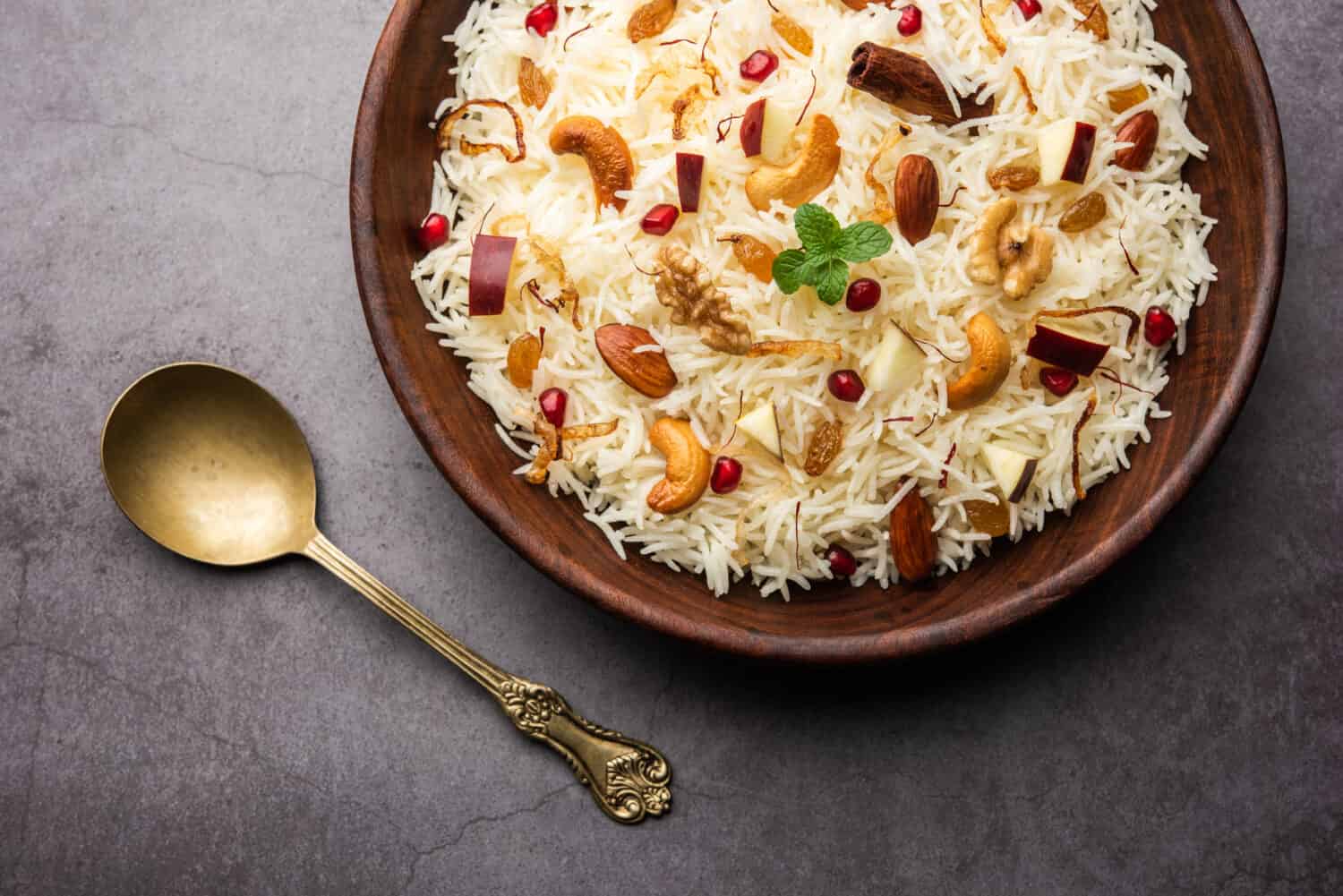As you make your way down the grocery aisle in search of rice for your family's next meal, you're met with a plethora of options. But what are the differences between all of them? And are all forms of rice healthy? Two popular items you may find are basmati rice and white rice, but it can be confusing to know what sets these two types of grain apart.
For starters, basmati rice is lower on the glycemic scale than white rice. It has a low to medium glycemic index, making it part of a heart-healthy diet. White rice, on the other hand, has a higher glycemic index.
Of course, many other things differentiate these two types of rice. From origin to flavor, color, and nutrients, let's take a closer look at basmati rice vs. white rice to see which one is healthier. Here's everything you need to know.
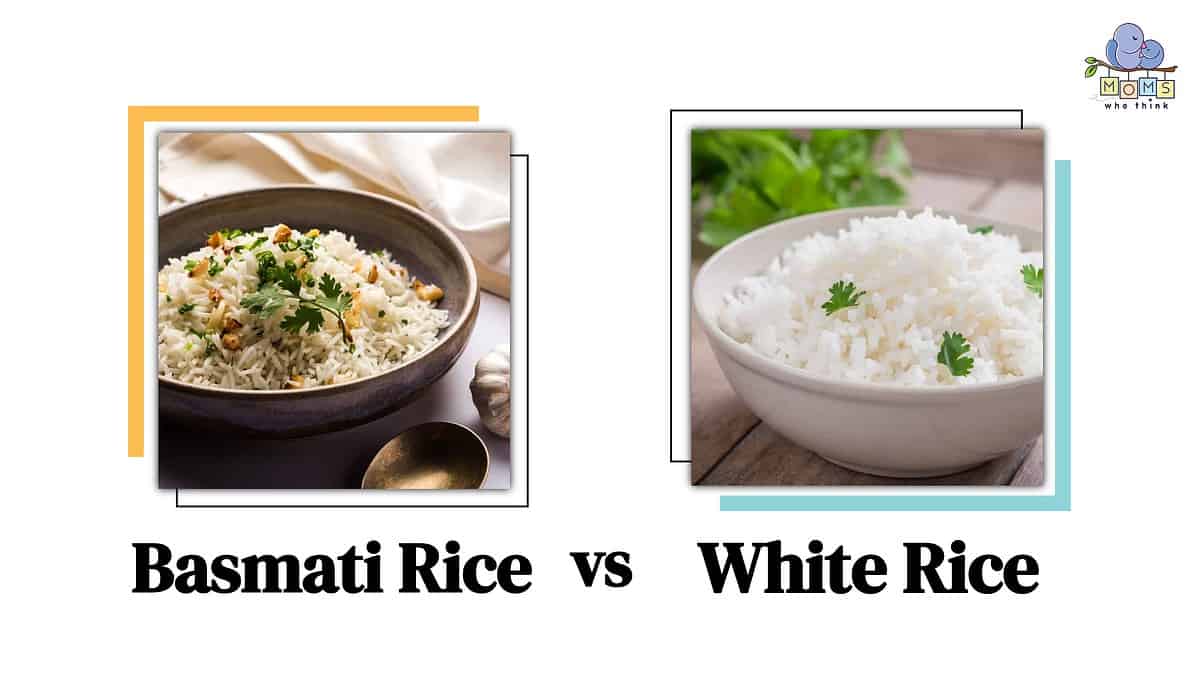
©
What is Basmati Rice?
Basmati is a long-grain variety of rice that originates from India and the foothills of the Himalayan mountains. Its signature nutty flavor is used predominantly in Indian cuisine like curry, and it's often seasoned and served alongside meat dishes.
This rice is also known for its strong aroma. While it may appear similar to other long-grain types of rice, one smell lets you know that basmati is different. In fact, the name basmati means “fragrant” in Hindi. According to The Kitchn, basmati receives its slightly sweet scent from the compound 2-Acetyl-1-pyrroline that's found in the food. Some also describe basmati rice as having a popcorn-like scent.
Types of Basmati Rice
While basmati is known to be the longest-grain type of rice, it can also be found in two different variations: Brown and white. Brown basmati is less processed and generally offers more nutrients and health benefits than white basmati rice. The white version goes through an additional process to remove the outer covering of the grain and the germ, leaving only the white starchy part of the grain for consumption.
How to Prepare Basmati Rice
When preparing basmati rice, it's important to at least rinse the rice to remove extra starch. Some prefer to soak the rice before cooking, but keep in mind that this will create a sticker finished product. Traditional basmati rice is light and fluffy and doesn't need to be soaked.
After the rice has been at least rinsed, it can either be boiled on the stove or steamed. Another option for preparing basmati rice is to try the “pilaf” method. This includes sauteeing the rice in oil and spices first, then adding liquid, covering the pan, and placing it all in the oven. Once the liquid is absorbed, the rice is ready to eat.
What is White Rice?
White rice is a broad term that covers many different varieties of rice. Essentially, rice that's been stripped of its hull and germ is considered to be white. While this type of rice is more processed than brown rice, it's also easier to digest and mild in flavor, making it a popular ingredient worldwide. The USDA reports that rice is the “primary staple food for more than half the world's population.” The highest-consuming countries are Asia, Sub-Saharan Africa, and South America.
Types of White Rice
Because white rice is a broad term that includes many different varieties, there are many different forms. The biggest difference between white rice varieties is the grain size. Short-grain white rice is typically wider than it is long and includes varieties like sushi and sticky rice. Medium-grain white rice is the most common and is about as long as it is wide. Long-grain white rice is longer than it is wide. This is where you'll find varieties like white basmati and jasmine rice.
How to Prepare White Rice
White rice alone is relatively easy to prepare and doesn't require additional seasoning. It's most often boiled or steamed in a rice cooker. You can prepare minute rice in under 5 minutes, while regular white rice takes longer to process. Keep in mind, however, that quicker cooking white rice is more processed.
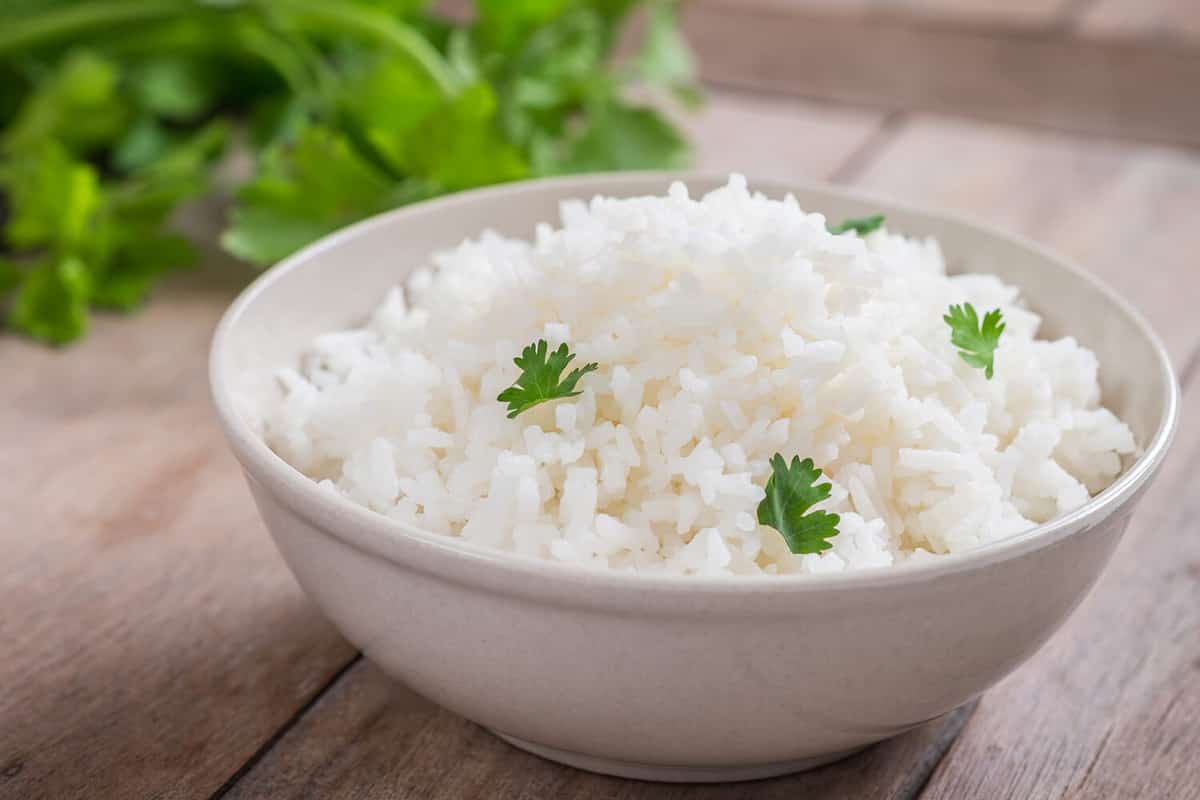
©Amarita/Shutterstock.com
Basmati Rice vs. White Rice: What are the Differences?
We've discussed the glycemic index difference between these two types of rice, but let's take a closer look at what sets them apart.
Origin
Basmati and white rice originate from different areas of the world. As mentioned, basmati is grown and harvested at the foothills of the Himalayan mountains. More specifically, the Northern Indian region of Punjab and Pakistan. According to the Institute of Agriculture & Trade Policy, basmati rice is thought to have been discovered and farmed for more than 250 years in this area of the world.
White rice, on the other hand, is found worldwide but originates and is largely consumed in China and Southeast Asia. It's thought that this crop has been grown and consumed for more than 10,000 years. The National Library of Medicine notes that rice has been found in archeological sites dating back to 8,000 B.C., but it's thought to have been in production even earlier.
Aroma and Flavor
Basmati rice is known specifically for its slightly sweet and popcorn-like scent. Some also identify the rice as having a light floral scent as well. Basmati is famous for its nutty flavor that some compare to jasmine rice.
White rice, however, is very mild and neutral in flavor. It's often used as a base for many dishes because it doesn't provide much flavor on its own.
Grain Type and Texture
Basmati is a long-grain rice that's generally tapered at each end. It's known to be the longest grain and even grows a bit when cooking. It also has a golden hue due to the aging process that's used before the rice is packaged and sold. This rice is light and fluffy when prepared as well.
White rice is typically consumed as a short or medium-grain rice. It will always be white and depending on the variety, can be sticky and clumped together. This is due to the higher starch amounts that tend to be found in white rice.
Basmati Rice vs. White Rice: Nutritional Value
White basmati rice and plain white rice are nearly identical in nutritional value. Keep in mind, however, that basmati has more fiber, plus less arsenic. Nutritional value is subject to change depending on type and brand, too.
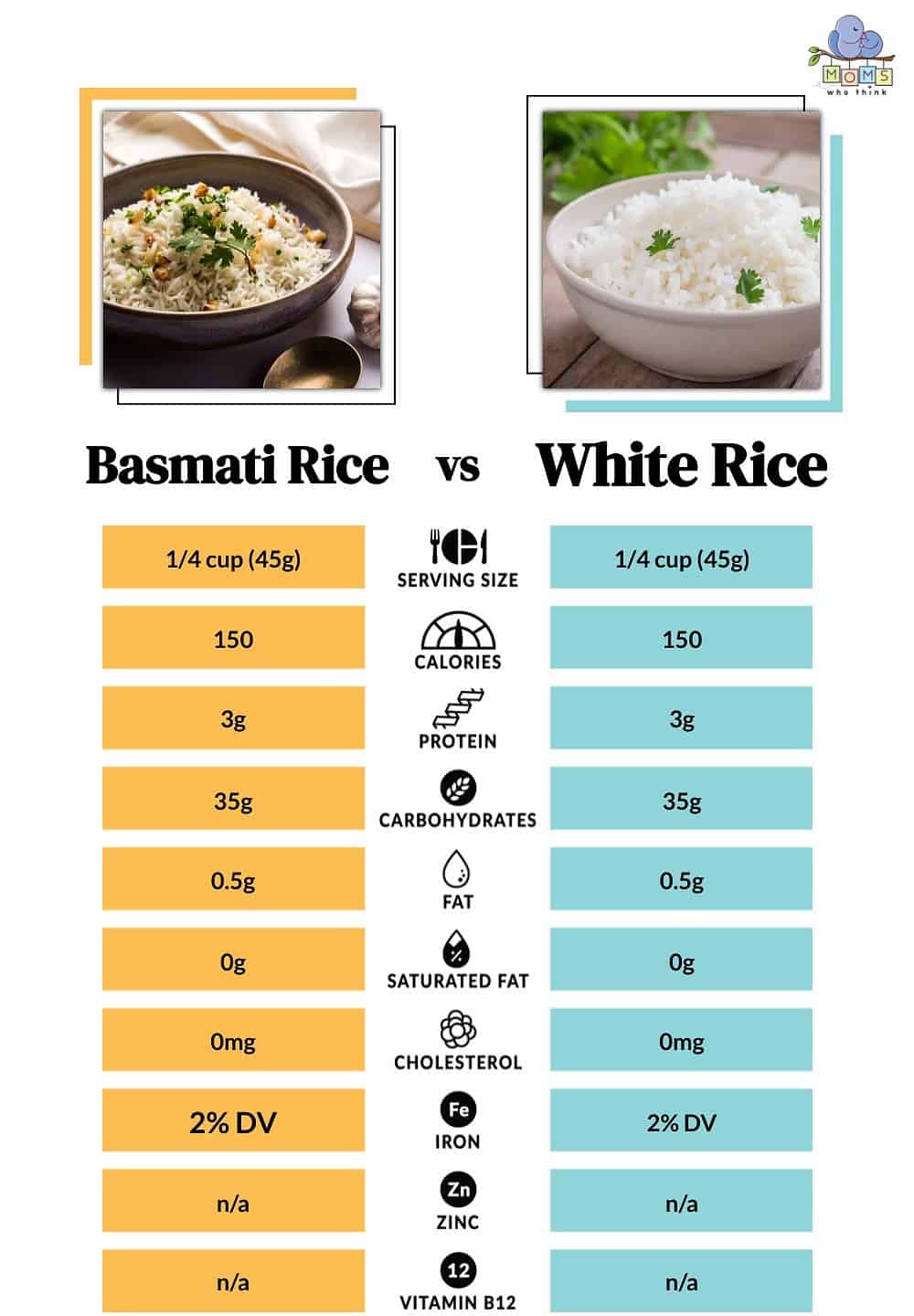
©
Which One is Healthier: Basmati or White Rice?
This depends on your nutritional needs, but in general, brown basmati rice is seen as a healthier option than plain white rice due to less processing. Brown basmati is considered a whole grain food option and it has essential nutrients like fiber and B vitamins. As discussed, it's also lower on the glycemic index than white rice, making it an appropriate option for those with diabetes.
Additionally, WebMD reports that basmati rice can offer health benefits such as reducing the risk of cancer and improved heart and brain health.
Can You Substitute Basmati Rice for White Rice?
Yes, you can! Just remember that basmati is a long-grain type of rice and has a different flavor and aroma than white rice, so this may alter your finished dish.
Here are a few other substitute options if you're in a pinch or simply want to try something different:
Other Substitutes for Basmati Rice
Basmati is nutty in flavor and a long-grain variety, so the best substitutes for this rice include:
- Jasmine rice, which is also long-grain and has a similar flavor
- Long-grain brown rice, which offers a similar texture and may have more nutrients than white basmati
- Carolina gold rice, which resembles basmati's flavoring
- Wild rice, which is grown and produced in North America has an earthy taste
Other Substitutes for White Rice
White rice has a mild flavor and can easily be substituted with the following:
- Brown rice, which has more nutrients and is less processed
- Cauliflower rice, which is a veggie option if you're looking to reduce carbs
- Quinoa, which offers more whole-grains
- Farro, which has higher levels of fiber and protein, but still resembles white rice's texture
Final Thoughts
Basmati rice and white rice may appear similar, but they have differing textures, flavors, and aromas. They are also grown and used in different areas of the world. Basmati is popular in Indian and Pakistani dishes, while white rice is grown worldwide and predominantly used in Asian cuisine. As you prepare your next recipe and try to decide which rice to use, keep in mind your personal preferences as well as your nutritional goals. Both basmati and white rice bring their own uniqueness to the kitchen!
Recipe Card
Print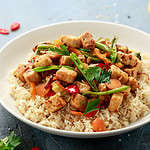
Chicken Stir-Fry with Garlic Ginger Sauce and White Rice
- Total Time: 30 minutes
Ingredients
For the Stir-Fry:
- 1 lb boneless, skinless chicken breasts, thinly sliced
- 2 cups broccoli florets
- 1 bell pepper, thinly sliced
- 1 carrot, julienned
- 1 cup snap peas, ends trimmed
- 3 cups cooked white rice
- 2 Tablespoons vegetable oil
- Sesame seeds and chopped green onions for garnish (optional)
For the Garlic Ginger Sauce:
- 1/4 cup soy sauce
- 2 Tablespoons oyster sauce
- 1 Tablespoon rice vinegar
- 1 tablespoon honey
- 2 teaspoons cornstarch
- 1 Tablespoon vegetable oil
- 3 cloves garlic, minced
- 1 Tablespoon fresh ginger, minced
Instructions
In a small bowl, whisk together all the ingredients for the Garlic Ginger Sauce. Set aside.
Heat 1 Tablespoon of vegetable oil in a wok or large skillet over medium-high heat.
Add sliced chicken and stir-fry until cooked through. Remove the cooked chicken from the wok and set aside.
In the same wok, add another tablespoon of oil. Stir-fry broccoli, bell pepper, carrot, and snap peas until they are crisp-tender.
Add the cooked chicken back to the wok and pour the garlic ginger sauce over the chicken and vegetables. Stir well to coat everything in the sauce. Cook for an additional 2-3 minutes until the sauce thickens.
Serve the chicken and vegetable stir-fry over a bed of cooked white rice.
Garnish with sesame seeds and chopped green onions if desired.
Nutrition
- Calories: 450
- Sugar: 9 g
- Sodium: 800 mg
- Fat: 12g
- Fiber: 4 g
- Protein: 25 g
- Cholesterol: 70 mg
The image featured at the top of this post is ©StockImageFactory.com/Shutterstock.com.
